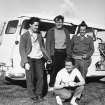Tulloch Of Assery
Chambered Cairn (Neolithic)
Site Name Tulloch Of Assery
Classification Chambered Cairn (Neolithic)
Alternative Name(s) Loch Calder; Tulloch Of Assery B
Canmore ID 7907
Site Number ND06SE 16
NGR ND 0676 6186
Datum OSGB36 - NGR
Permalink http://canmore.org.uk/site/7907
- Council Highland
- Parish Halkirk
- Former Region Highland
- Former District Caithness
- Former County Caithness
ND06SE 16 0676 6186.
A well-preserved chambered round cairn (Cat 70), probably the later one of the two chambered cairns known as the Tullochs of Assery. (See also ND06SE 9) Before excavation by Corcoran in 1961 in advance of the raising of the level of Loch Calder, it was a large circular, grass-covered mound, about 110ft in diameter and over 12ft high with no evidence of a chamber. The excavation revealed an eccentrically set chamber with an entrance passage in the SE, a massive internal revetting wall and an outer wall-face of good quality masonry. Corcoran regarded the cairn as being of one build but Miss Henshall suggests two phases. Finds from the excavation in the National Museum of Antiquities of Scotland (NMAS).
J X W P Corcoran 1967; A S Henshall 1972; NMAS 1977.
Cairn resurveyed at 1:25,000
Visited by OS 3 November 1964.
Corcoran's excavation remains open but otherwise the cairn is well-preserved although the water of the loch lap its margins and have caused some damage.
Visited by OS 17 August 1981.
ND 0676 6186 During September 2004 a chambered cairn at Loch Calder (Tulloch of Assery B; ND06SE 16) was surveyed. The site was previously investigated by Corcoran in the 1960s in advance of the raising of the loch level. However, since that time the loch has continued to actively erode parts of the site. The 2004 work was undertaken to record new structural features that have appeared and to record the extent of the erosion.
The project is part of a wider analysis of chambered cairn construction (Caithness Architecture Project) and is related to a project undertaken at Spittal during July 2004. Here, elements of a chambered cairn were reconstructed by members of the local community, directed by the authors.
J Barber, A Heald and J Henderson 2004
Excavation (1961)
Before excavation by Corcoran in 1961 in advance of the raising of the level of Loch Calder, it was a large circular, grass-covered mound, about 110ft in diameter and over 12ft high with no evidence of a chamber. The excavation revealed an eccentrically set chamber with an entrance passage in the SE, a massive internal revetting wall and an outer wall-face of good quality masonry. Corcoran regarded the cairn as being of one build but Miss Henshall suggests two phases. Finds from the excavation in the National Museum of Antiquities of Scotland (NMAS).
J X W P Corcoran 1967
































